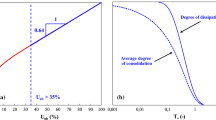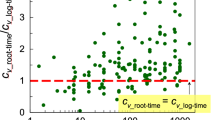Abstract
Measured excess pore pressure dissipation responses always present a different trend from those theoretically expected. A simple hyperbolic equation for estimating the coefficient of consolidation [c h(Hyp)] was thus proposed based on the indirect fit between both responses. The method was applied to dissipation test data in the normally consolidated clay of Nakdong River Delta. The result indicates that c h(Hyp) values vary with the normalized excess pore pressure (U), showing different trends according to the patterns of both curves. The mean values estimated with four theoretical solutions vary within a difference of 200%, and are close to those of the consolidation tests. The coefficients of consolidation obtained using three conventional methods, which are based on the direct fits at U = 50% and between the early or late parts of both curves, lie within or out of the range of c h(Hyp). The coefficients of permeability estimated using the mean values of c h(Hyp) underestimate those of the laboratory permeability test and those of an empirical formula based on the piezocone sounding records.
Similar content being viewed by others
References
Abu-Farsakh, M. Y. and Nazzal, M. D. (2005). “Reliability of piezocone penetration test methods for estimating the coefficient of consolidation of cohesive soils.” Transportation Research Record, No. 1913, pp. 62–76.
Baligh, M. M. and Levadoux, J. N. (1986). “Consolidation after undrained piezozone penetration, II: Interpretation.” Journal of Geotechnical Engineering, ASCE, Vol. 112, No. 7, pp. 727–745.
Burns, S. E. and Mayne, P. W. (1998). “Monotonic and dilatory pore pressure decay during piezocone tests inclay.” Canadian Geotechnical Journal, Vol. 35, No. 6, pp. 1063–1073.
Cai, G. J., Liu, S. Y., Puppala, A. J., Tong, L. Y., and Du, G. Y. (2010). “Estimation of consolidation coefficient from piezocone dissipation tests in Jiangsu Quaternary clay deposits, China.” Proc. GeoFlorida- 2010 Conference, ASCE, pp. 1018–1028.
Chai, J. C., Agung, P. M. A., Hino, T., Igaya, Y., and Carter, J. P. (2011). “Estimating hydraulic conductivity from piezocone soundings.” Géotechnique, Vol. 61, No. 8, pp. 699–708.
Chai, J. C., Sheng, D., Carter, J. P., and Zhu, H. (2012). “Coefficient of consolidation from non-standard piezocone dissipation tests.” Computers and Geotechnics, Vol. 41, pp. 13–22.
Chen, B. S. Y. and Mayne, P. W. (1994). Profiling the OCR of clays by piezocone tests, Report No. CEEGEO-94-1, Georgia Institute of Technology, Atlanta, U.S.A.
Chu, J., Bo, M. W., Chang, M. F., and Choa, V. (2002). “Consolidation and permeability properties of Singapore marine clay.” Journal of Geotechnical and Geoenvironmental Engineering, ASCE, Vol. 128, No. 9, pp. 724–732.
Chung, S. G., Choi, G. H., Choi, H. K., and Cho, K. Y. (1998). “Root time method for consolidation analysis.” Journal of Korean Geotechnical Society, Vol. 14, No. 2, pp. 41–53. (in Korean)
Chung, S. G. and Kweon, H. J. (2013). “Oil-operated fixed piston sampler and its applicability.” J. of Geotechnical and Geoenvironmental Engineering, ASCE, Vol. 139, No. 1, pp. 134–142.
Chung, S. G., Kweon, H. J., and Jang, W. Y. (2014). “A hyperbolic fit method for interpretation of piezocone dissipation tests.” J. of Geotechnical and Geoenvironmental Engineering, ASCE, Vol. 140, No. 1, pp. 251–254.
Chung, S. G., Lee, N. K., and Kim, S. R. (2009). “Hyperbolic method for prediction of prefabricated vertical drains performance.” J. of Geotechnical and Geoenvironmental Engineering, ASCE, Vol. 135, No. 10, pp. 1519–1528.
Chung, S. G., Lee, N. K., Lee, J. M., Min, S. C., and Hong, Y. P. (2010). “Hydraulic characteristics of Busan clay in the floodplain of the Nakdong river delta.” Journal of Korean Geotechnical Society, Vol. 26, No. 11, pp. 47–61 (in Korean).
Chung, S. G., Ryu, C. K., Min, S. C., Lee, J. M., Hong, Y. P., and Odgerel, Enkhtur (2012). “Geotechnical characterisation of Busan clay.” KSCE Journal of Civil Engineering, KSCE, Vol. 16, No. 4, pp. 341–350.
Danziger, F. A. B., Almeida, M. S. S., and Sills, G. C. (1997). “The significance of the strain path analysis in the interpretation of piezocone dissipation data.” Géotechnique, Vol. 47, No. 5, pp. 901–914.
Elswroth, D. and Lee, D. S. (2005). “Permeability determination from on-the-fly piezocone sounding.” J. Geotech. Geoenviron. Engng., Vol. 131, No. 5, pp. 643–653.
Elsworth, D. and Lee, D. S. (2007). “Limits in determining permeability from on-the-fly uCPT sounding.” Géotechnique, Vol. 57, No. 8, pp. 769–685.
Gillespie, D. and Campanella, R. G. (1981). “Consolidation characteristics from pore pressure dissipation after piezometer cone penetration.” Soil Mechanics Series No. 47, Dept. of Civil Engineering, The University of British Coulombia, Vancouver, Canada.
Lunne, T., Robertson, P. K., and Powell, J. J. M. (1997). Cone penetration testing in geotechnical practice, Blackie Academic and Professional.
Mayne, P. W. (2001). “Stress-strain-strength-flow parameters from enhanced in-situ tests.” Proceedings of International Conference on In-situ Measurement of Soil Properties and Case Histories, Bali, Indonesia, pp. 27–48.
Randolph, M. F. and Wroth, C. P. (1979). “An analytical solution for the consolidation around a driven pile.” International J. of Numerical and Analytic Methods in Geomechanics, Vol. 3, No. 3, pp. 217–229.
Robinson, R.G. and Allam, M. M. (1996). “Determination of coefficient of consolidation from early stage of log t plot.” Geotechnical Testing Journal, ASTM, Vol. 19, No. 3, pp. 316–320.
Robertson, P. K., Sully, J. P., Woeller, D. J., Lunne, T., Powell, J. J. M., and Gillespie, D. G. (1992). “Estimating coefficient of consolidation from piezocone tests.” Canadian Geotechnical Journal, Vol. 29, No. 4, pp. 539–550.
Rust, E. and Clayton, C. R. I. (1999). “Interpretation of incomplete dissipation data from piezocone tests.” Proc. Inst. Civil Engnrs, Geotechnical Engineering, Vol. 137, No. 2, pp. 97–103.
Schnaid, F., Sills, G. C., Soares, J. M., and Nyirenda, Z. (1997). “Predictions of the coefficient of consolidation from piezocone tests.” Canadian Geotechnical Journal, Vol. 34, No. 2, pp. 315–327.
Soderberg, L. O. (1962). “Consolidation theory applied to foundation pile time effects.” Géotechnique, Vol. 12, No. 3, pp. 217–225.
Sridharan, A. and Prakash, K. (1985). “Improved rectangular hyperbola method for the determination of coefficient of consolidation.” Geotechnical Testing Journal, ASTM, Vol. 8, No. 1, pp. 37–40.
Sully, J. P., Robertson, P. K., Campanella, R. G., and Woeller, D. J. (1999). “An approach to evaluation of field CPTU dissipation data in overconsolidated fine-grained soils.” Canadian Geotechnical Journal, Vol. 36, No. 2, pp. 369–381.
Tan, T. S., Inoue, T., and Lee, S. L. (1991). “Hyperbolic method for consolidation analysis.” J. Geotech. Engrg., ASCE, Vol. 117, No. 11, pp. 1723–1737.
Tavenas, F., Tremblay, M., Larouche, G., and Leroueil, S. (1986). “In situ measurement of permeability in soft clays.” ASCE Specialty Conf. In Situ 86, Blacksburg, VA, pp. 1034–1048.
Teh, C. I. (1987). An analytical study of the cone penetration test, PhD Thesis, Dept. of Civil Engineering, Oxford University.
Teh, C. I. and Houlsby, G. T. (1991). “An analytical study of the cone penetration test in clay.” Géotechnique, Vol. 41, No. 1, pp. 17–34.
Torstensson, B. A. (1975). “Pore pressure sounding instrument.” Proceedings of the ASCE Specialty Conference on In-situ Measurement of Soil Properties ISMOSP, Raleigh, Vol. 2, pp. 48–54.
Torstensson, B.-A. (1977). “The pore pressure probe.” Nordiske Geotekniske Mote, Oslo, Paper No. 34, pp. 34.1–34.15.
Yune, C. Y. and Chung, C. K. (2005). “Consolidation test at constant rate of strain for radial drainage.” Geotechnical Testing Journal, Vol. 28, No. 1, pp. 71–78.
Author information
Authors and Affiliations
Corresponding author
Rights and permissions
About this article
Cite this article
Jang, W.Y., Chung, S.G. & Kweon, H.J. Estimation of coefficients of consolidation and permeability via piezocone dissipation tests. KSCE J Civ Eng 19, 621–630 (2015). https://doi.org/10.1007/s12205-013-1418-2
Received:
Revised:
Accepted:
Published:
Issue Date:
DOI: https://doi.org/10.1007/s12205-013-1418-2




